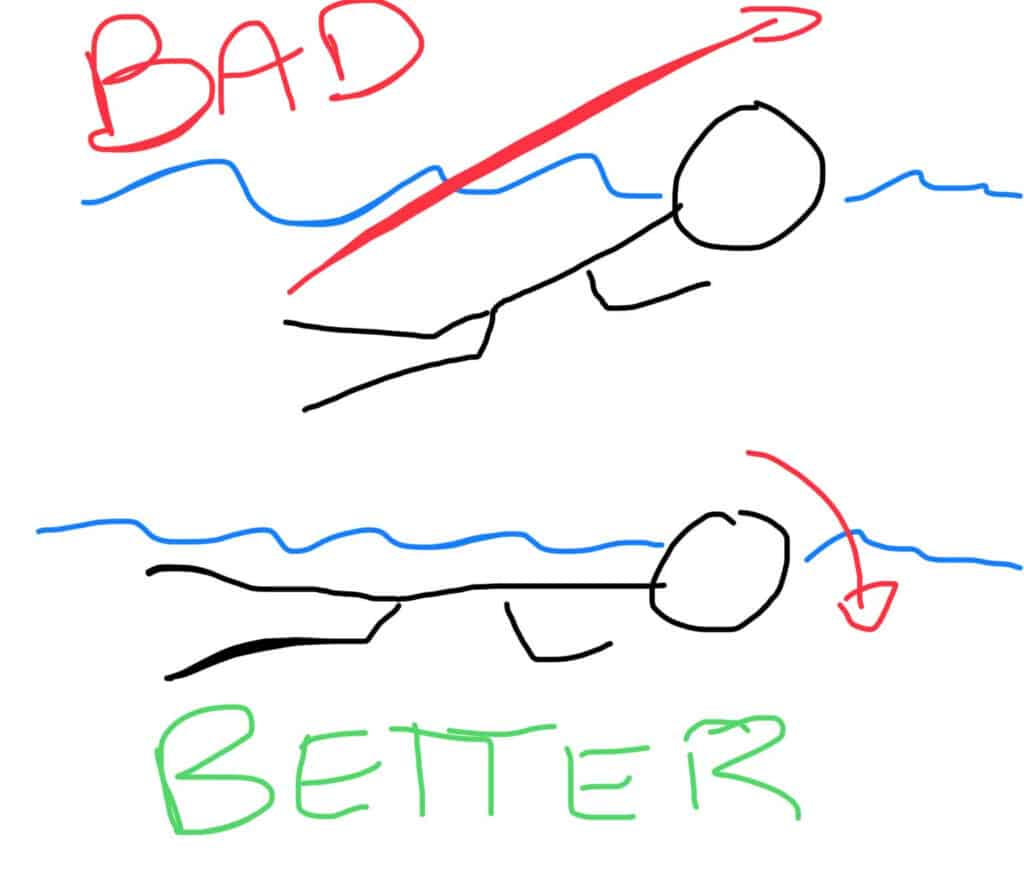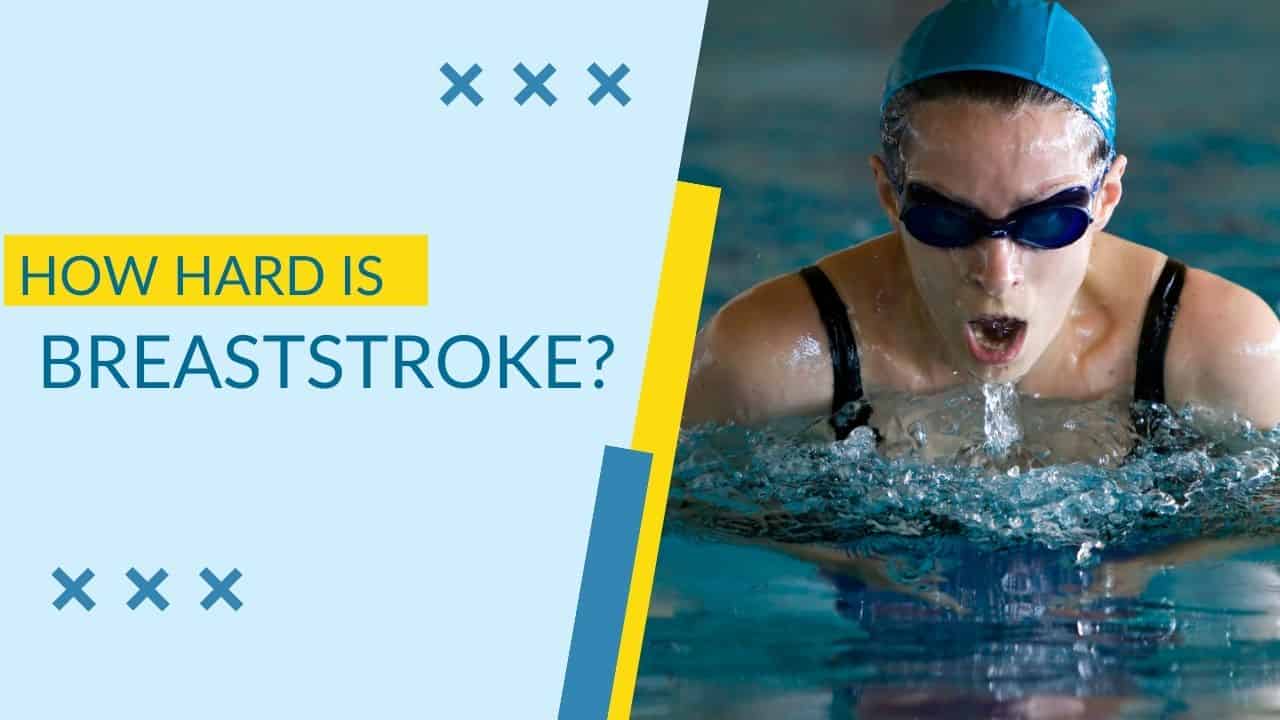There was one thing I was never allowed to do as a high school swimmer.
While this may sound silly, I was explicitly forbidden from ever racing breaststroke in competitions…
Why?
Because I would get disqualified every time 🤦.
While some casual swimmers think of breaststroke as a relaxing way to swim, but I know firsthand just how difficult this stroke can be.
Let’s “dive in” and explore how hard is breaststroke by comparing it to other strokes and other exercises.
Table of Contents
- How hard is breaststroke… defining “hard”
- How hard is breaststroke- energy expenditure
- The Technical Demands of Breaststroke
- The Challenges of Competitive Breaststroke Racing
- Frequently asked questions
Please do not confuse my personal blog for medical advice. Please consult with a healthcare professional before starting or altering any training plan. This post may contain affiliate links. If you make a purchase after clicking on a link, I get a small percentage of the sale at no additional cost to you.
How hard is breaststroke… defining “hard”
Before we dive into the specifics of breaststroke difficulty, we need to define what we mean by “hard.”
- Are we talking about how exhausting the stroke is or how much energy it takes to perform breaststroke? ⚡(Here are some tips on swimming breaststroke without getting tired).
- Are we talking about how hard it is to master breaststroke technique or how much coordination is required to swim breaststroke effectively? 💪
- Or are we talking about how hard it is to race breaststroke competitively? 🏆
Clearly, there are many ways to think about how hard breaststroke is. Let’s start by looking at how many calories breaststroke burns compared to other strokes.

How hard is breaststroke- energy expenditure
Ah, the slow and steady breaststroke – we’ve all seen grandmas leisurely swimming laps with this stroke, not even getting their hair wet because their face is above water the entire time. (It may be possible to swim breaststroke even after hip replacement surgery!)
But let’s be real – when it comes to competitive breaststroke, the story is a bit different.
Breaststroke is a stroke that demands proper form and timing, making it a challenging stroke to perform efficiently.
That being said, don’t expect breaststroke to be the most calorie-burning stroke out there.
According to the Compendium of Physical Activities, breaststroke only burns 5.3 METs for recreational swimming, which is the second least of any stroke after backstroke. For a 160-pound man, this equates to around 385 calories burned per hour. (If you’re curious, butterfly burns the most calories…)
However, it’s worth noting that the number of calories burned during breaststroke can vary depending on factors such as the intensity and duration of the swim.
For example, a competitive race will burn more calories than a leisurely lap swim. Additionally, your body will affect how many calories you burn. If you weigh more, you’ll burn more calories than a smaller person. And let’s face it, while breaststroke may not burn the most calories, it still burns more energy than sitting on the couch.
The Technical Demands of Breaststroke
Breaststroke is not only physically challenging but also requires proper technique and timing to perform efficiently.
In competitive breaststroke, there are specific rules and guidelines that swimmers must follow to avoid disqualification. In fact, there are more ways to get disqualified (DQ’ed) in breaststroke than any other stroke!
Proper Form
One of the most critical elements of breaststroke is maintaining proper form throughout the stroke. This includes having your head low in the water which helps keep your hips high. (Note that your head must break the plane of the water on every stroke). You also should focus on keeping your elbows tucked in during the pull phase. Proper form ensures that you’re using the right muscles to generate power and maintain efficiency.

Related post: What does “swimming downhill” mean for Total Immersion?
Timing
Timing is another crucial aspect of breaststroke that can make or break your performance. Proper timing ensures that your movements are synchronized and efficient. Timing includes the timing of your breathing, your arm movements, and your kick. According to the rule book, “the stroke cycle must be one arm stroke and one leg kick in that order”. Perfecting your timing takes practice and patience… (or if you’re like me, you might just quit and focus on freestyle 🙃)
Kicking
Breaststroke requires a unique kick that can take some time to master. The kick involves keeping your legs close together and kicking out and around in a circular motion, like a frog. Swimmers must also turn their feet outwards during the propulsive phase of the kick. Kicking efficiently requires proper technique and timing, as well as a good deal of leg strength.
Rules and Guidelines
In competitive breaststroke, swimmers must adhere to specific rules and guidelines to avoid disqualification. Some of these rules include touching the wall with both hands at the end of each lap, keeping your head mostly in the water, and keeping your feet turned out during the propulsive phase of the kick. Swimmers who fail to follow these rules risk disqualification from the race.
The Challenges of Competitive Breaststroke Racing
Breaststroke is definitely the hardest stroke to master. However, some swimmers take to the stroke quite naturally. These natural breaststrokers dominate the sport and are amazing to watch.
Adam Peaty of the UK is the current world record holder in the 100m breaststroke with a time of 56.88 seconds. Which I think is way faster than I could even dream of swimming a 50m breaststroke… if I didn’t get disqualified first.
While breaststroke is the slowest stroke, breaststroke races are quite competitive and are some of the most enjoyable races to watch because you can easily follow each swimmers stroke as they pop up out of the water.
Frequently asked questions
Is breaststroke easier than freestyle?
It depends on your skill and technique. Some swimmers may find breaststroke easier due to the slower pace and less demand for oxygen, while others may prefer the more straightforward technique and faster pace of freestyle.
How much faster is freestyle than breaststroke?
The exact speed difference varies depending on the swimmer’s skill level and race distance. However, if we look at world record times, the 100m freestyle WR is 10 seconds faster than the 100m breaststroke record. (About 18% faster).
Can breaststroke improve my posture?
Yes, breaststroke can help improve your posture by strengthening your upper back and core muscles. The proper form required for breaststroke swimming involves maintaining a straight spine and engaging your back muscles, which can lead to improved posture over time.
How long does it take to learn breaststroke?
Learning breaststroke can take anywhere from a few weeks to several months, depending on the swimmer’s natural ability, level of dedication, and access to proper instruction and practice time. Mastery of the stroke can take even longer and requires ongoing practice and refinement of technique.

About the author
Hi! I’m Sam. And I’m a nerd. Swimming Nerd. Gear Nerd. Triathlon Nerd. I swam in high school and have even done a few sprint and Olympic distance triathlons. I’m excited to share my love of swimming with you through this site!

